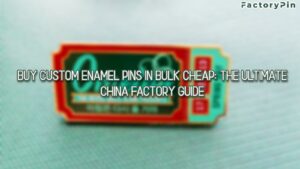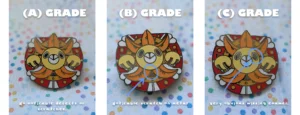Enamel pins are everywhere—from fashion accessories to collectibles to branding tools. But while the final product may be small, the craftsmanship behind it is anything but simple. In this blog, we won’t repeat what everyone already says. We’ve made a full video to walk you through the general steps of production—so here, we’ll focus on what really matters: the details that make Factorypin’s work different.
Watch the full process:
A Brief Overview
The typical enamel pin journey starts with turning your design into a physical mold. From there, metal sheets are stamped into shape, trimmed, polished, filled with enamel, baked, plated, and finally inspected and packaged. It sounds straightforward—but each of these steps has layers of technique behind it.
Many factories follow the same broad sequence. What makes the difference is how each stage is handled. The pressure of the mold press, the way colors are mixed, the quality of plating, the feel of the polish—these are the choices that separate a pin that just looks okay from one that truly stands out.

At Factorypin, we’ve refined each of these steps with care, combining handcraft techniques with modern precision. And that’s where we’d like to focus today: not on the steps themselves, but on the craftsmanship that brings them to life.
Where Quality Is Made: In the Details
Hand-Polishing the Metal Base
After stamping and cutting the mold, the raw metal pieces—known as blanks—often come out with rough edges and burrs. Many factories use machines to tumble and smooth these edges, which works for bulk processing. But in our workshop, this step is done by hand using compact polishing tools. It allows the surface to be felt directly and ensures that the edges are smooth to the touch before any coloring or plating begins. When the piece feels right in the hand, we know it’s ready to move on.
Filling by Hand for Complex Designs
Enamel filling can be done with machines for large-scale, simple designs. But for many pins—especially those with intricate shapes or tiny gaps—machine-filling can miss or overflow details. That’s why we still rely on hand-filling for most of our orders. Skilled workers use fine tools to apply color section by section, carefully avoiding overflows and making sure every area is filled with the right amount. This process takes more time but brings out the full character of the design.
Color Matching: It’s an Art, Not a Formula
One of the most common sources of frustration for designers is color matching. On paper, it sounds simple: just provide a PMS color code, and the factory should match it. But anyone who has made enamel pins knows—it’s rarely that straightforward.
Enamel color is mixed by hand from raw pigments, and matching it perfectly to a digital PMS swatch often involves more art than science. Light, material, and enamel texture all affect how a color appears once applied and baked.
Some designers expect the pin to look exactly like their screen preview, and they’re understandably disappointed when the final product feels too dull, too vibrant, or just… off. We’ve had clients come to us after a bad first experience elsewhere, unsure how to explain what went wrong—only able to say things like “can it feel a bit warmer?” or “I imagined it more pastel.”
That’s where experience matters. Our color specialists don’t just mix by code; they compare colors by eye, under natural light, and know how to interpret vague feedback into real, visual results. Over the years, they’ve developed a kind of intuition—how a small shift toward gray can soften a harsh tone, or how to brighten a color without making it feel neon. It’s this sensitivity that often helps bring a client’s vision to life, even when they can’t quite describe it.

Special Effects Require Skilled Hands
Adding special effects like glitter, glow-in-the-dark, or translucent enamel may sound simple—but getting them just right takes skill. Some clients imagine it as a button you press, but in reality, these effects often require manual control. Glitter needs to be mixed evenly before each fill, and transparent layers must be placed with precision to avoid clouding.
These small touches make a design come alive, but only when handled with care. That’s why we rely on experienced hands for these steps—no shortcut replaces judgment and attention to detail.
Real Gold Plating That Lasts
Not all gold finishes are created equal. Some manufacturers use imitation gold that looks fine at first but quickly shows dull patches or stains that won’t clean off. We use real gold plating on most of our premium orders—not only for its richer tone but also for its durability.
Many clients are surprised at how easy it is to maintain: a quick wipe is often enough to restore the shine. In sunlight, the difference between real and fake gold is hard to miss—and once you’ve seen it, you won’t want to go back.

A Legacy of Care, Not Just Production
For us, enamel pins aren’t just something we produce—they’re something we craft. Factorypin began serving international customers over a decade ago, and we’ve stayed true to the same core values: detail, honesty, and lasting quality.
Over the years, we’ve helped artists, small businesses, collectors, and global brands bring their designs to life. Some come to us with just a sketch and an idea. Others return year after year because they know what they’ll get: personal support, real attention to detail, and a team that actually cares about the end result.
We’re not the biggest. But we believe we might just be the most thoughtful.
Want to see your design become a high-quality enamel pin? Contact us and let us help you make something you’ll be proud to hold.





